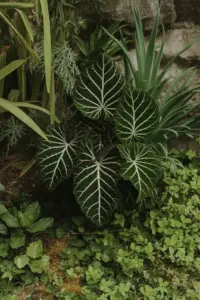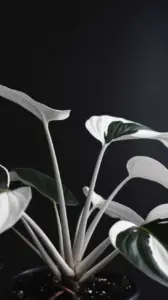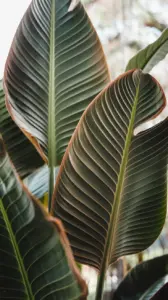Biological Features of Anthurium Crystallinum
Anthurium Crystallinum is a stunning tropical plant known for its striking leaves and impressive structure. It belongs to the family Araceae, which contains many flowering plants. Its leaves are heart-shaped, broad, and feature a deep green color with distinctive white veins.
This plant thrives in humid environments, typically found in rainforests. The Anthurium Crystallinum can grow up to 3 feet tall and 2 feet wide. Its size makes it an excellent choice for indoor or outdoor displays. Moreover, it prefers well-draining soil rich in organic matter.
Additionally, the Anthurium Crystallinum produces inflorescences. These feature a long, spadix, surrounded by a colorful spathe. The flowers, however, are not the main attraction. The foliage steals the spotlight, offering unique color patterns and textures.
Distinctive Characteristics
Some notable biological features of Anthurium Crystallinum include:
| Feature | Description |
|---|---|
| Leaf Shape | Heart-shaped and broad |
| Leaf Color | Deep green with white veins |
| Height | Up to 3 feet |
| Width | Up to 2 feet |
| Preferred Environment | Humid, tropical settings |
| Soil Type | Well-draining, organic-rich soil |
In summary, the Anthurium Crystallinum stands out due to its eye-catching foliage and robust growth. Gardeners and plant enthusiasts highly value this tropical beauty not just for its visual appeal, but also for its unique structure.
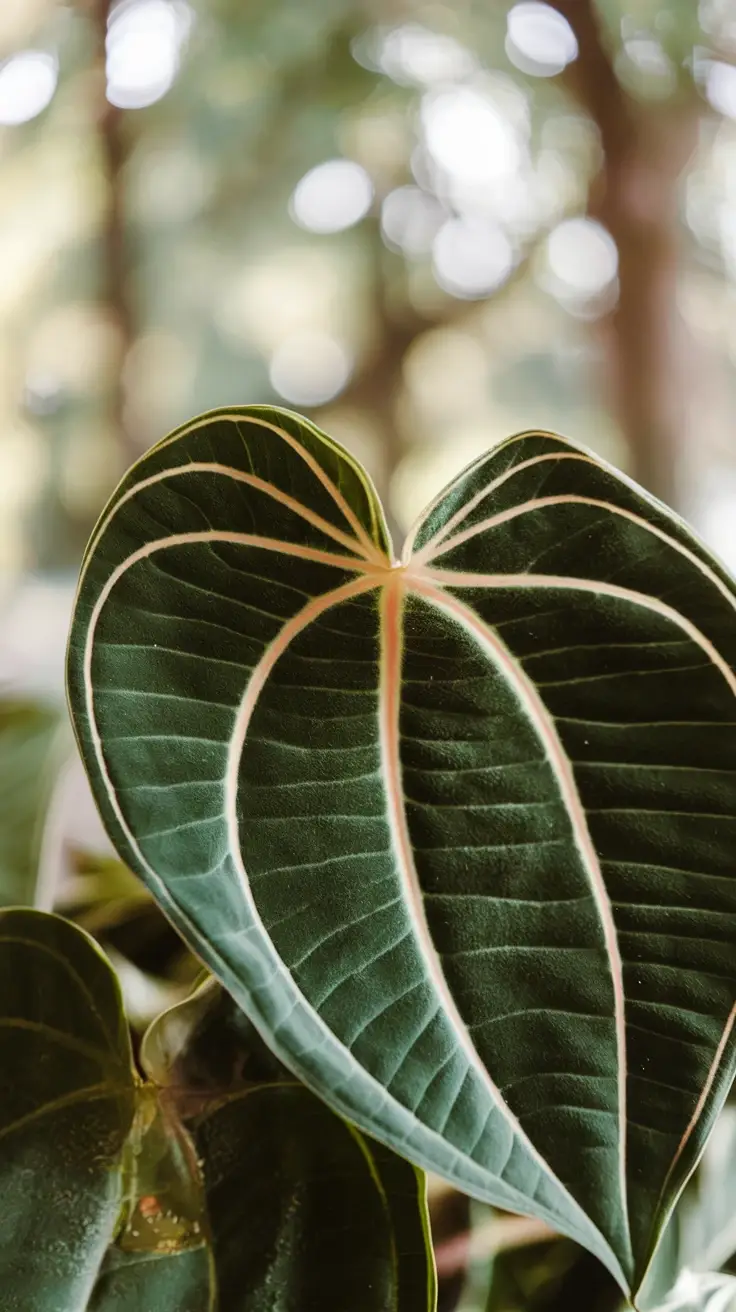
History and Cultural Significance
Anthurium Crystallinum, often admired for its stunning foliage, has a rich history rooted in Central and South America. This plant captivates enthusiasts with its heart-shaped leaves and striking white veining. Historically, it has been an integral part of the indigenous cultures in these regions. This plant symbolizes hospitality and love, making it a popular gift in many cultures.
Due to its beauty and unique features, Anthurium Crystallinum gained attention in European botanical circles during the 19th century. Collectors and botanists sought after this stunning species, leading to a surge in hybrid varieties. As a result, it is now cultivated worldwide, bringing a piece of its native environment into homes.
In addition to its aesthetic appeal, this plant also has cultural implications. In some traditions, it is believed to bring prosperity and good fortune. Gardeners and plant lovers often consider it a symbol of growth and renewal. As it flourishes in homes, it serves as a reminder of the rich ecosystems from which it originated.
Key Cultural Aspects
- Symbol of Love: Often given as a gift to express affection.
- Prosperity and Good Fortune: Many cultures regard it as a bringer of luck.
- Indigenous Importance: Used in traditional ceremonies by local tribes.
- Artistic Representation: Its unique shape and vibrant colors inspire various art forms.
Today, Anthurium Crystallinum continues to thrive in gardens, homes, and exhibitions. Its popularity in the floral industry highlights its timeless appeal. As people cultivate this plant, they also celebrate its rich cultural significance.
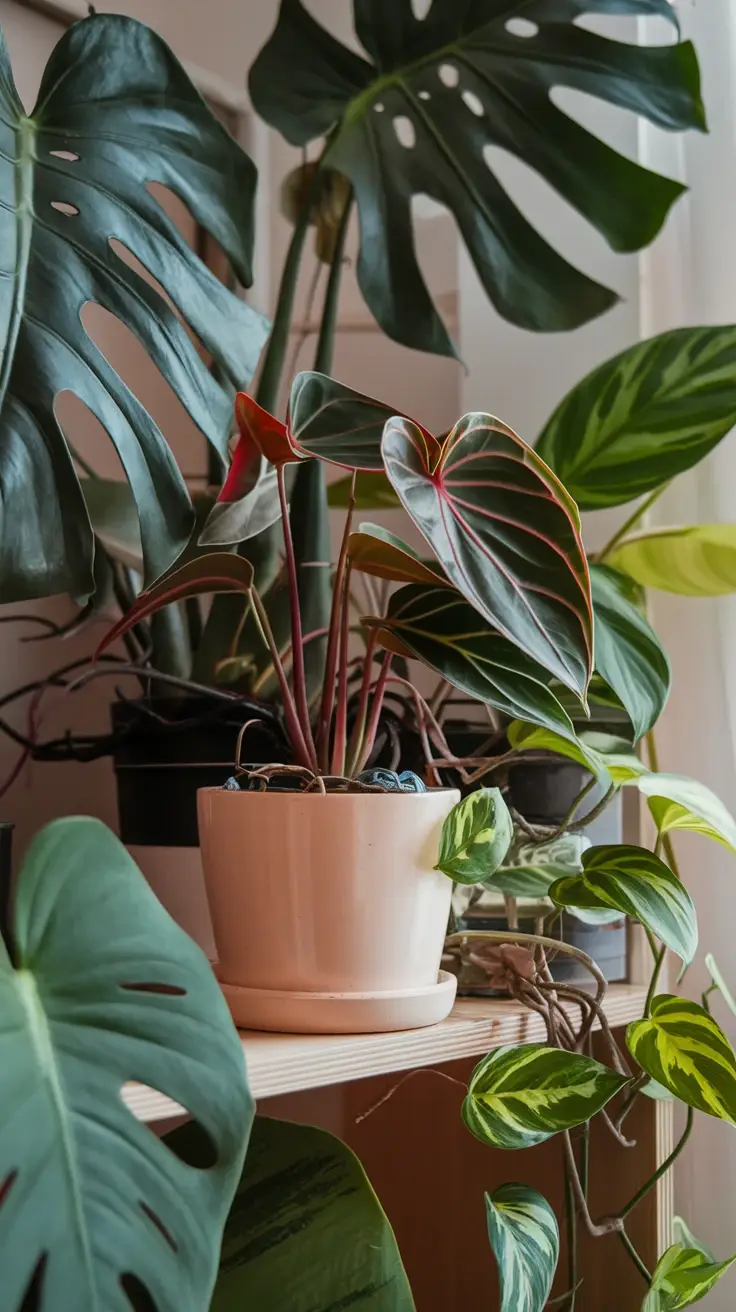
Ideal Growing Conditions for Anthurium Crystallinum
Anthurium Crystallinum thrives in conditions that mimic its native tropical environment. To ensure the health and vibrancy of your Anthurium Crystallinum, consider the following factors:
Light Requirements
This plant prefers bright, indirect light. Direct sunlight can scorch its beautiful leaves. Ideally, place your Anthurium Crystallinum near a north or east-facing window. If the light is too low, the plant may not bloom as abundantly.
Temperature and Humidity
Anthurium Crystallinum enjoys warm temperatures between 65°F to 85°F (18°C to 29°C). It also thrives in high humidity levels, typically around 60% to 80%. For optimal growth, consider using a humidifier or placing a pebble tray with water beneath the pot. Regular misting can help maintain moisture as well.
Soil Type
Well-draining soil is crucial for Anthurium Crystallinum. A mix of potting soil, orchid bark, and perlite works wonders. This combination ensures good aeration and moisture retention without becoming overly saturated.
Watering
Water this plant when the top inch of soil feels dry. Overwatering can lead to root rot, so ensure proper drainage. Reduce watering during the winter months when the plant’s growth slows down.
Nutrients
Fertilize Anthurium Crystallinum every four to six weeks during the growing season. A balanced, water-soluble fertilizer diluted to half strength is ideal. This ensures your plant receives the necessary nutrients for lush foliage and blooms.
| Condition | Details |
|---|---|
| Light | Bright, indirect light |
| Temperature | 65°F to 85°F (18°C to 29°C) |
| Humidity | 60% to 80% |
| Soil | Well-draining mix (potting soil, orchid bark, perlite) |
| Watering | When top inch of soil is dry |
| Fertilizing | Every 4-6 weeks during growing season |
In summary, adjust these conditions to provide your Anthurium Crystallinum with the best environment for growth. By doing so, you will enjoy healthy plants throughout the year.

Plant Care and Maintenance
The Anthurium Crystallinum thrives in the right conditions. To promote healthy growth, it’s essential to focus on light, water, humidity, and soil. Each aspect plays a crucial role in the plant’s overall well-being.
Light Requirements
Anthurium Crystallinum prefers bright, indirect light. Too much direct sunlight can scorch its beautiful leaves. If possible, place your plant near a window with sheer curtains. During the shorter days of winter, supplement with grow lights if necessary. This keeps the energy levels high.
Watering
Watering this plant correctly is vital. Overwatering can lead to root rot, while underwatering can cause the leaves to droop. The soil should remain slightly moist but never soggy. Water when the top inch of soil feels dry, ensuring good drainage in pots. Always use clean, room-temperature water.
Humidity and Temperature
High humidity is ideal for Anthurium Crystallinum. Aim for humidity levels between 60-80%. If your home is dry, consider using a humidifier or placing a tray of water near the plant. This can enhance its growth and vibrancy. Additionally, maintain a temperature range of 65-85°F (18-29°C) for optimal growth.
Soil Type
Choose a well-draining potting mix specifically designed for tropical plants. A mix rich in organic matter is ideal. Ensure it retains moisture while allowing excess water to escape. This balance is essential for healthy root development.
Fertilization
During the growing season, fertilize the plant every 4-6 weeks. Use a balanced, water-soluble fertilizer diluted to half strength. Avoid fertilizing in fall and winter when the plant is dormant.
Pruning and Repotting
Prune any yellow or damaged leaves to maintain health. Regularly inspect the plant for pests and trim where necessary. Repot every 1-2 years or when the plant outgrows its container. This promotes growth and provides fresh soil nutrients.
Pest and Disease Management
Common pests include spider mites and aphids. Inspect your Anthurium Crystallinum regularly. If pests appear, treat them promptly with insecticidal soap or neem oil. Be sure to isolate diseased plants to prevent issues from spreading.
Conclusion
With proper care and attention, your Anthurium Crystallinum will thrive. By understanding its needs, you contribute to its health and longevity.
- Provide bright, indirect light.
- Keep soil slightly moist.
- Maintain high humidity levels.
- Use a well-draining potting mix.
- Fertilize during the growing season.
- Prune and repot as necessary.
Propagation Techniques for Anthurium Crystallinum
Propagating Anthurium Crystallinum successfully will allow you to expand your collection. This process can be done through various methods, but the most common options are division and offsets. Both techniques encourage new growth while ensuring the parent plant remains healthy.
To propagate through division, start by carefully removing the Anthurium Crystallinum from its pot. Gently shake off excess soil to reveal the root system. Identify natural divisions in the plant; look for sections with at least two leaves and a healthy root ball. Use sterilized scissors or a sharp knife to separate these sections. After cutting, it is crucial to let the cut surfaces dry for a few hours. This helps to prevent rot.

Next, prepare new pots for your divided plants. Fill these pots with a well-draining potting mix, such as a blend of peat, perlite, and orchid bark. Place each division carefully in its pot and fill around the roots with the potting mix. Water lightly, letting excess moisture drain.
The offsets method involves waiting until small plants develop at the base of the parent Anthurium Crystallinum. These can be gently separated from the main plant in the same manner as divisions. Ensure each offset has its roots for successful transplantation.
After planting, it is vital to keep the soil consistently moist but not soggy. Place the pots in an area with plenty of indirect light. Also, maintaining a high humidity level is important; this can be achieved using a humidity tray or misting the plants periodically.
In summary, whether using division or offsets, successful propagation of Anthurium Crystallinum involves careful handling and attention to plant needs. Following these techniques will result in healthy new plants ready to thrive in their own environments.
Common Problems and Solutions
Anthurium Crystallinum enthusiasts often face several common issues. Understanding these challenges can enhance your plant care skills. Here are some frequent problems and practical solutions.
- Yellowing Leaves: This can indicate overwatering or insufficient nutrients. Reduce watering habits and feed your plant with a balanced fertilizer.
- Wilting: Wilting leaves often signal underwatering. Ensure you water the plant thoroughly when the top inch of soil feels dry.
- Brown Leaf Tips: High humidity is essential for this plant. Consider misting the leaves or placing a humidifier nearby.
- Pests: Aphids and spider mites can affect your Anthurium Crystallinum. Regularly inspect the leaves and use insecticidal soap for treatment.
- Leaf Drop: Sudden changes in temperature can cause leaf drop. Keep your plant in a stable environment away from drafts.
Table of Common Problems
| Problem | Symptoms | Solutions |
|---|---|---|
| Yellowing Leaves | Leaves turning yellow and droopy | Reduce watering and fertilize appropriately |
| Wilting | Soft and limp leaves | Water thoroughly when the soil is dry |
| Brown Leaf Tips | Tips of the leaves brown and crispy | Increase humidity levels around the plant |
| Pests | Visible insects on the leaves | Use insecticidal soap or neem oil |
| Leaf Drop | Leaves falling off suddenly | Maintain consistent temperature and avoid drafts |
Engaging with these solutions should make caring for your Anthurium Crystallinum more enjoyable. Regular monitoring and prompt action will help keep it healthy.
Seasonal Care Adjustments
Proper care for an Anthurium Crystallinum involves adjusting your routines according to the seasons. This ensures your plant remains healthy and vibrant throughout the year. Seasonal changes can greatly impact the watering, lighting, and humidity needs of your Anthurium.
Watering
During the warmer months, you may need to increase watering frequency. In contrast, reduce it during winter when the plant’s growth slows down.
Lighting
Anthurium Crystallinum thrives in bright, indirect light. However, direct sunlight can scorch its leaves. In winter, consider moving it closer to a light source, but avoid harsh rays.
Humidity
This plant loves high humidity. Use a humidifier or mist the leaves regularly, especially during dry winter months.
- Adjust watering based on seasonal temperature changes.
- Provide bright, indirect light for healthy growth.
- Maintain humidity levels to prevent leaf dryness.
- Monitor for pests which can be more active in warmer months.
- Repot in spring if you notice root crowding.
Keep an eye on your Anthurium Crystallinum’s leaves. If they curl or brown, this indicates adjustments are needed in care practices.
Microclimate Setup Tips
Creating the right microclimate for your Anthurium Crystallinum is essential for healthy growth. It thrives in conditions that mimic its natural habitat. Start by ensuring the right humidity levels. Ideal humidity ranges from 60% to 80%. You can achieve this by using a humidifier or placing a pebble tray filled with water below the pot.
Temperature is another critical factor. Anthurium Crystallinum prefers temperatures between 65°F and 80°F (18°C to 27°C). Avoid placing it near drafts or heat sources like radiators. This plant benefits from adequate air circulation but dislikes strong winds.
Lighting is vital for vibrant foliage. Bright, indirect light is optimal. Consider placing your plant near an east-facing window. If the light is too intense, use sheer curtains to diffuse it.
- Humidity: Maintain levels between 60% to 80% using humidifiers or pebble trays.
- Temperature: Ensure a consistent range of 65°F to 80°F; avoid cold drafts.
- Light: Provide bright, indirect light; east-facing windows are ideal.
- Soil: Use a well-draining, organic potting mix to prevent root rot.
- Watering: Water when the top inch of soil feels dry; overwatering can damage roots.
- Fertilizing: Feed with a balanced fertilizer every 4-6 weeks during the growing season.
By following these tips, you can create a supportive microclimate for your Anthurium Crystallinum, allowing it to thrive beautifully in your home.
Frequently Asked Questions
Anthurium Crystallinum often raises various questions among plant enthusiasts. Understanding the care and characteristics of this striking plant can help nurture it effectively. One common question is about watering. Anthurium Crystallinum thrives in well-drained soil. Therefore, it’s essential to ensure that the soil remains moist but not soggy.
Another frequent inquiry pertains to lighting. This plant prefers bright, indirect sunlight. Too much direct light can scorch the leaves, so it’s vital to find the right balance. Many also wonder about humidity levels. Anthurium Crystallinum flourishes in high humidity environments; hence, misting the leaves can be beneficial.
Additionally, some people ask about fertilization schedules. During the growing season, a balanced liquid fertilizer every month can promote healthy growth. Lastly, pests like spider mites and aphids may occasionally invade. Regular inspection and treatment can help maintain plant health, ensuring your Anthurium Crystallinum remains vibrant and thriving.
Summary and Recommendations
Anthurium Crystallinum is a stunning houseplant known for its striking foliage and ease of care. This plant thrives in bright, indirect sunlight. It prefers high humidity and well-draining soil for optimal growth. Regular misting can help meet its humidity needs.
When watering, ensure the top inch of soil dries out before rewatering. Overwatering can lead to root rot, a serious issue for Anthurium Crystallinum. Fertilize the plant during the growing season with a balanced fertilizer every four to six weeks. In winter, reduce feeding.
For best results, rotate your plant regularly. This practice ensures even growth and prevents it from leaning towards the light source. Provide support if the stems become leggy. Overall, with the right care, Anthurium Crystallinum can flourish and make a beautiful addition to any indoor space.

